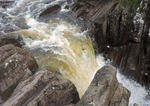Cambusmore (Stirling)
Category C listed buildings in Stirling (council area)Country houses in Stirling (council area)Houses in Stirling (council area)Scottish building and structure stubs

Cambusmore is a country house in Stirling, Scotland, located 1 mile (1.6 km) southeast of the town of Callander. Situated on a tributary on the northern banks of the River Teith, it is located in an area which prior to 1975 formed part of the historic county of Perthshire. The main house is of Georgian style with a porte-cochère tower and later extensions. Following recognition of John Michael Baillie-Hamilton Buchanan as the Chief of Clan Buchanan in 2018, Cambusmore became the current seat of the Clan.
Excerpt from the Wikipedia article Cambusmore (Stirling) (License: CC BY-SA 3.0, Authors, Images).Cambusmore (Stirling)
A84,
Geographical coordinates (GPS) Address Nearby Places Show on map
Geographical coordinates (GPS)
| Latitude | Longitude |
|---|---|
| N 56.229166666667 ° | E -4.1777777777778 ° |
Address
A84
FK17 8LJ
Scotland, United Kingdom
Open on Google Maps






